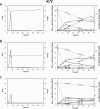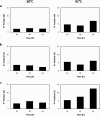Effect of oxygenation and temperature on glucose-xylose fermentation in Kluyveromyces marxianus CBS712 strain
- PMID: 24712908
- PMCID: PMC3991920
- DOI: 10.1186/1475-2859-13-51
Effect of oxygenation and temperature on glucose-xylose fermentation in Kluyveromyces marxianus CBS712 strain
Abstract
Background: The yeast Kluyveromyces marxianus features specific traits that render it attractive for industrial applications. These include production of ethanol which, together with thermotolerance and the ability to grow with a high specific growth rate on a wide range of substrates, could make it an alternative to Saccharomyces cerevisiae as an ethanol producer. However, its ability to co-ferment C5 and C6 sugars under oxygen-limited conditions is far from being fully characterized.
Results: In the present study, K. marxianus CBS712 strain was cultivated in defined medium with glucose and xylose as carbon source. Ethanol fermentation and sugar consumption of CBS712 were investigated under different oxygen supplies (1.75%, 11.00% and 20.95% of O2) and different temperatures (30°C and 41°C). By decreasing oxygen supply, independently from the temperature, both biomass production as well as sugar utilization rate were progressively reduced. In all the tested conditions xylose consumption followed glucose exhaustion. Therefore, xylose metabolism was mainly affected by oxygen depletion. Loss in cell viability cannot explain the decrease in sugar consumption rates, as demonstrated by single cell analyses, while cofactor imbalance is commonly considered as the main cause of impairment of the xylose reductase (KmXR) - xylitol dehydrogenase (KmXDH) pathway. Remarkably, when these enzyme activities were assayed in vitro, a significant decrease was observed together with oxygen depletion, not ascribed to reduced transcription of the corresponding genes.
Conclusions: In the present study both oxygen supply and temperature were shown to be key parameters affecting the fermentation capability of sugars in the K. marxianus CBS712 strain. In particular, a direct correlation was observed between the decreased efficiency to consume xylose with the reduced specific activity of the two main enzymes (KmXR and KmXDH) involved in its catabolism. These data suggest that, in addition to the impairment of the oxidoreductive pathway being determined by the cofactor imbalance, post-transcriptional and/or post-translational regulation of the pathway enzymes contributes to the efficiency of xylose catabolism in micro-aerobic conditions. Overall, the presented work provides novel information on the fermentation capability of the CBS712 strain that is currently considered as the reference strain of the genus K. marxianus.
Figures




Similar articles
-
High-temperature ethanol production by a series of recombinant xylose-fermenting Kluyveromyces marxianus strains.Enzyme Microb Technol. 2019 Oct;129:109359. doi: 10.1016/j.enzmictec.2019.109359. Epub 2019 Jun 14. Enzyme Microb Technol. 2019. PMID: 31307575
-
Improving ethanol and xylitol fermentation at elevated temperature through substitution of xylose reductase in Kluyveromyces marxianus.J Ind Microbiol Biotechnol. 2013 Apr;40(3-4):305-16. doi: 10.1007/s10295-013-1230-5. Epub 2013 Feb 8. J Ind Microbiol Biotechnol. 2013. PMID: 23392758
-
Improved xylose fermentation of Kluyveromyces marxianus at elevated temperature through construction of a xylose isomerase pathway.J Ind Microbiol Biotechnol. 2013 Aug;40(8):841-54. doi: 10.1007/s10295-013-1282-6. Epub 2013 May 9. J Ind Microbiol Biotechnol. 2013. PMID: 23657586
-
Engineering of Saccharomyces cerevisiae for the efficient co-utilization of glucose and xylose.FEMS Yeast Res. 2017 Jun 1;17(4). doi: 10.1093/femsyr/fox034. FEMS Yeast Res. 2017. PMID: 28582494 Review.
-
Kluyveromyces marxianus as a host for heterologous protein synthesis.Appl Microbiol Biotechnol. 2016 Jul;100(14):6193-6208. doi: 10.1007/s00253-016-7645-y. Epub 2016 Jun 3. Appl Microbiol Biotechnol. 2016. PMID: 27260286 Review.
Cited by
-
Model-based biotechnological potential analysis of Kluyveromyces marxianus central metabolism.J Ind Microbiol Biotechnol. 2017 Aug;44(8):1177-1190. doi: 10.1007/s10295-017-1946-8. Epub 2017 Apr 25. J Ind Microbiol Biotechnol. 2017. PMID: 28444480
-
Improved secretory expression of lignocellulolytic enzymes in Kluyveromyces marxianus by promoter and signal sequence engineering.Biotechnol Biofuels. 2018 Aug 29;11:235. doi: 10.1186/s13068-018-1232-7. eCollection 2018. Biotechnol Biofuels. 2018. PMID: 30279722 Free PMC article.
-
Ploidy Variation in Kluyveromyces marxianus Separates Dairy and Non-dairy Isolates.Front Genet. 2018 Mar 21;9:94. doi: 10.3389/fgene.2018.00094. eCollection 2018. Front Genet. 2018. PMID: 29619042 Free PMC article.
-
Codon Optimization Improves the Prediction of Xylose Metabolism from Gene Content in Budding Yeasts.Mol Biol Evol. 2023 Jun 1;40(6):msad111. doi: 10.1093/molbev/msad111. Mol Biol Evol. 2023. PMID: 37154525 Free PMC article.
-
Recent Advances in the Biosynthesis of Natural Sugar Substitutes in Yeast.J Fungi (Basel). 2023 Sep 7;9(9):907. doi: 10.3390/jof9090907. J Fungi (Basel). 2023. PMID: 37755015 Free PMC article. Review.
References
-
- Lane MM, Morrissey JP. Kluyveromyces marxianus: A yeast emerging from its sister’s shadow. Fungal Biol Rev. 2010;24:7–26.
Publication types
MeSH terms
Substances
LinkOut - more resources
Full Text Sources
Other Literature Sources
Miscellaneous

